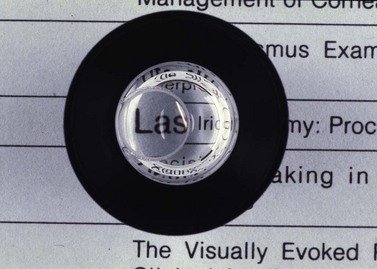CHAPTER 44 Laser peripheral iridotomy and iridoplasty
Laser peripheral iridotomy
The continuous wave argon laser revolutionized the treatment of glaucoma. In 1973, Beckman and Sugar reported successful argon laser iridotomies in humans1. Others soon reported success in human eyes with angle closure2. The ease and convenience of the procedure for both patient and surgeon and the paucity of severe complications led to its rapid acceptance. ALPI was first described in 19823.
Indications
Acute primary angle closure
A recent randomized controlled trial reported that LPI may not be as effective as early phacoemulsification in reversing angle closure and preventing the subsequent IOP increase in acute angle closure eyes4. It was suggested that if LPI could be performed within 7 days after the onset of symptoms in acute angle closure the chance of successful post-iridotomy IOP control would be higher5. After LPI in acute angle closure eyes, up to 55.6% may still have appositionally closed angles6. It is therefore important to monitor both the drainage angle and IOP in acute angle closure patients following LPI.
Chronic angle closure
LPI alone may control IOP, or elevated IOP may persist as a result of prior trabecular damage, warranting continued medical treatment or filtration surgery. Failure of medications to control IOP, particularly if the angle is closed, does not mean necessarily that the IOP will be uncontrollable medically after iridotomy. It is often not possible to predict which eyes will respond favorably; in one series, LPI reduced the IOP in 44% of eyes in patients with chronic angle closure glaucoma7.
Other situations
Secondary angle closure glaucoma
In situations of angle closure secondary to other eye diseases, e.g. anterior uveitis or Behcet’s disease8, LPI may help relieve the pupillary block and reverse, partially or totally, the appositionally closed portions of the angle. This may improve IOP control.
Surgical techniques
The various techniques for LPI as developed in the late 1970s and early 1980s, with multiple variations, are detailed elsewhere9. We describe our current most commonly used techniques and settings.
Contact lenses for laser procedures
The Abraham lens (Fig. 44.1) consists of a fundus lens with an anterior +66 diopter planoconvex button. The button magnifies without loss of depth of focus. The effective size of a 50 µm spot is reduced to approximately 30 µm; this provides higher energy per unit area and permits the procedure to require a lower total energy. Posterior to the site of focus, the beam is more rapidly defocused, decreasing potential injury to structures behind.




